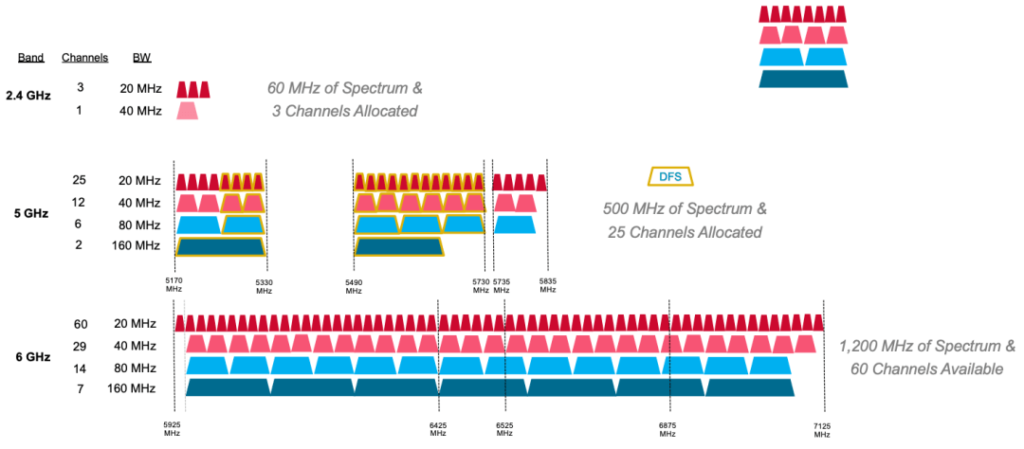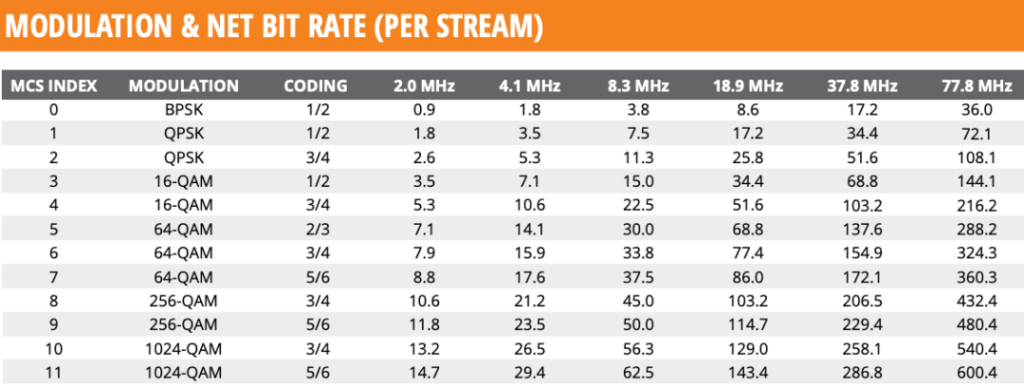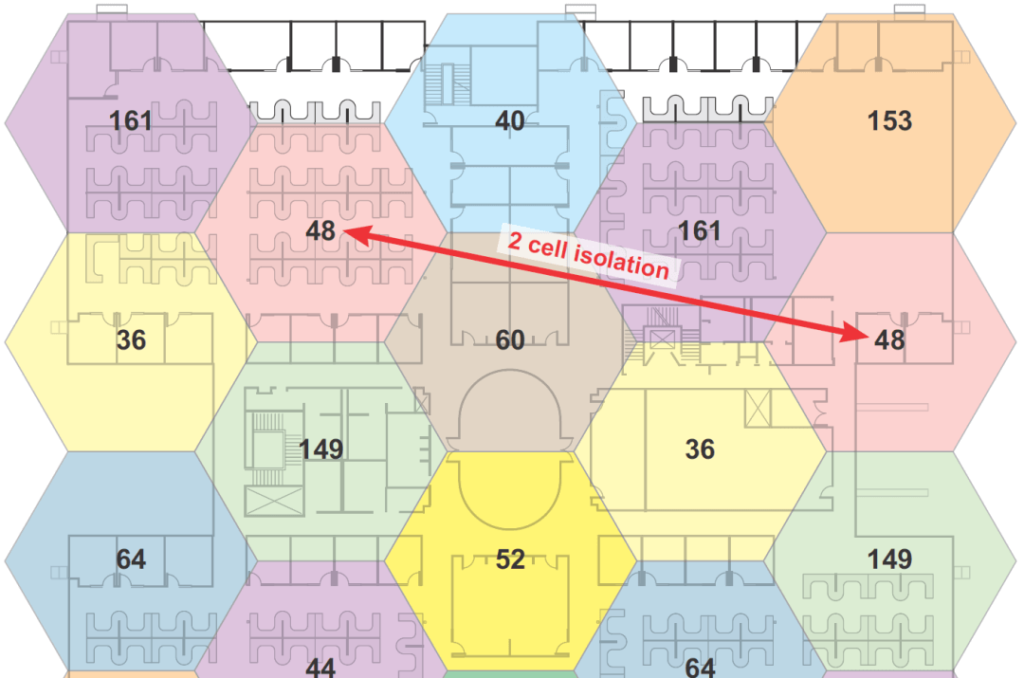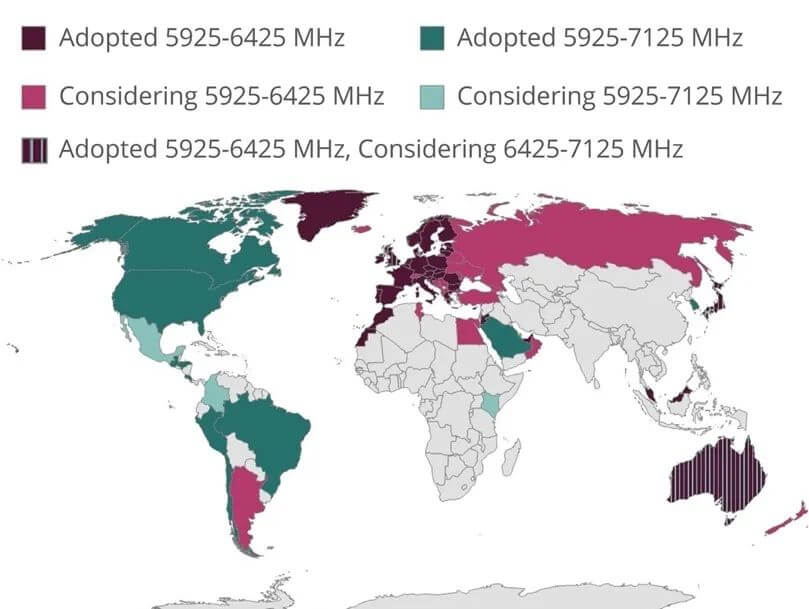After the read, you know why does Wi-Fi need 6GHz.
For the past 20 years or so, Wi-Fi has relied on only two bands, 2.4GHz and 5GHz (a total of more than 600MHz of the spectrum), to carry the ever-growing demand for the network.
Currently, the 2.4GHz and 5GHz bands used by 2.4GHz are already very crowded. This is reflected in the user experience in terms of increased network latency, decreased user rates, and interference between Wi-Fi routers becoming more frequent.
To address this challenge, shortly after the launch of Wi-Fi 6, the Wi-Fi industry actively promoted the development of Wi-Fi 6E.
Wi-Fi 6E follows the core technology of the current Wi-Fi 6 and expands network capacity by extending the operating band of Wi-Fi 6 to 6 GHz (5925-7125 MHz).
As shown in Figure 1, the addition of 1200 MHz allows Wi-Fi to increase its spectrum resources by two times compared to the past.

Figure 1 Wi-Fi band development history
Do you know why does Wi-Fi need 6GHz?
The 6GHz spectrum, for Wi-Fi, allows for a qualitative leap in performance. As we can see in Figure 2, 6GHz allows the number of Wi-Fi channels to be expanded by a factor of two.

Figure 2 Number of channels for 2.4GHz, 5GHz, and 6GHz Wi-Fi
In terms of the most commonly used 40MHz channel, 5GHz can provide 4 normal channels and 8 DFS channels. (Note: The function of the DFS channel is to protect the frequency used by radar from interference, and Wi-Fi will automatically avoid the channel when Wi-Fi devices detect that a radar is using the band)
And on 6GHz, there are up to 29 DFS-unrestricted 40MHz channels available for Wi-Fi devices to choose from.
Why does Wi-Fi need 6GHz and need so many channels?
To answer this question, you need to look at the various nodes of the network as a whole.
A bottleneck at any one node, from cell phones and computers to wireless routing and subsequent fiber networks, will not improve the performance of the network. In the past, in the era of 10 to 100 megabit fiber, the bottleneck in the network rate was often in the fiber network itself. Simply increasing the rate of Wi-Fi does not make much sense for the overall performance of the network.
Today, as the country’s dual-gigabit infrastructure projects advance, more and more homes can use optical networks with gigabit rates, and enterprise fiber networks can reach 10Gb.
Fiber optic technology is still being updated, with 50Gbps+ fiber optic technology appearing under the International Telecommunication Union (ITU) development blueprint as early as 2018, and it is not expected to take long for commercial products to emerge.

Figure 3 Theoretical maximum data rate for a single channel under Wi-Fi 6
With users already having gigabit fiber, such Wi-Fi performance becomes a bottleneck in the network. This is when it makes sense to increase the rate of Wi-Fi.
By increasing the bandwidth to 80MHz, the maximum rate can exceed 700Mbps, while 160MHz bandwidth is more than sufficient to meet the demand for gigabit fiber.
This trend of increasing bandwidth can also be verified from the analysis of users’ router usage. According to Cisco and Aruba’s analysis of their users, 80MHz bandwidth, nowadays, is gradually becoming the default option for homes and businesses when configuring Wi-Fi networks.
At this point of writing, you may be wondering, didn’t you mention in the last issue that technologies such as OFDMA, higher-order modulation, and more MIMO can increase the rate and network capacity? Why do we need to increase the channel resources?
In fact, the reason is very simple, there is no free lunch.
MIMO can provide multiple channels to increase the data rate, but the cost of one is to increase the channel requires the corresponding transceiver channels, which increases the power consumption of Wi-Fi devices.
Second, the introduction of higher-order modulation and more channels MIMO, means that the RF receiver for the wireless channel signal-to-noise ratio requirements is higher, which reduces the cell coverage and the degree of interference resistance of the device.
The root of OFDMA is how to distribute the cake to users more effectively, and not to make the cake bigger. Therefore, the most direct and effective way to increase the capacity is to widen the bandwidth and increase the spectrum resources.
You may still have questions, now the Wi-Fi 6 on 5GHz can also support 80 and 160MHz bandwidth? Why do we need Wi-Fi 6E?
To answer this one question, it needs to be discussed from the perspective of network multi-router deployment.
The current industry gold standard for dense Wi-Fi network deployments is the 7-channel reuse scheme. This scheme is an optimal optimization point to balance spectrum usage efficiency and inter-cell interference.
The 7-channel reuse scheme refers to six adjacent routes around a wireless route, all using different Wi-Fi channels.
Take the Wi-Fi deployment in the first-floor office space in Figure 4 as an example.

Figure 4, 7-channel Wi-Fi cell deployment scheme
With a network using the 7-channel reuse scheme, Wi-Fi cells of the same frequency can be separated from each other by two cells of different frequencies. Due to the long distance, the risk of co-channel interference between cells is minimal.
In the past, using a 40MHz channel base, this deployment was stress-free for the spectrum.
However, when users upgrade their channels to 80MHz bandwidth, the current 5GHz spectrum is not enough.
This is why Wi-Fi need 6GHz and where Wi-Fi 6E comes in handy.
From the channel map above, we can see that there are as many as 14 80MHz channels in 6GHz, which can fully meet the requirements. Even if in the future, users upgrade to 160MHz bandwidth, 6GHz can still provide 7 channels to meet the network deployment.
The current global development of Wi-Fi 6E
Wi-Fi 6E devices generally support the entire 6GHz, but in terms of the specific frequency range available, equipment manufacturers need to meet the frequency band requirements of each country.
The international spectrum allocation for 6GHz Wi-Fi is mainly in two directions, the first is a one-step approach based on ITU Region 2 (Americas), that is, the entire 1.2GHz spectrum (5925-7125MHz) is open for Wi-Fi use.
The second is a step-by-step approach, opening up 500MHz of the lower 6GHz band (5925-6425MHz) for Wi-Fi use first while continuing to study and wait on the planning of the higher 6GHz (6425-7125MHz).
This strategy is mainly held by the EU, Australia, Japan, and other countries.
One of the main reasons for this is that one of the important issues in WRC-23 Agenda 1.2 has an impact on the spectrum allocation in these countries and regions.
In this issue, the 6425-7125 MHz band may be identified as a mobile band in some regions for future 5G or even 6G use, and China is one of the active supporters of this issue.

Figure 5 Global Wi-Fi 6E development (data from Wi-Fi Alliance)
Starting from 2021, there are already a large number of terminals and network devices supporting Wi-Fi 6E. The entire Wi-Fi 6E ecosystem is currently gaining momentum, and more mainstream devices are expected to start supporting Wi-Fi 6E this year.
Will China approve the use of Wi-Fi 6E?
On the topic of 6GHz, our country’s Ministry of Industry and Information Technology’s attitude before and after WRC-19 has been to support the allocation of the entire 6GHz for 5G and future 6G mobile communications, and Wi-Fi 6E has not received much attention in China.
This has a lot to do with our country’s 5G industrial policy and the amount of spectrum currently available in the 5G mid-band.
From the data released by Qualcomm below, China only has 100MHz of 5G spectrum in the mid-band on 2.6GHz and 300MHz on 3.5GHz, which also includes 3.3-3.4GHz specifically allocated for indoor 5G use.
Overall, the total amount of the mid-band spectrum is less than the EU, North America, Japan, and South Korea.
However, starting last year, the Hong Kong SAR government took the lead in planning for the use of Wi-Fi 6E in Hong Kong. The impact of the current Wi-Fi network congestion on businesses and individuals was mentioned in a public call for views issued by the SAR Government last year.
After several months of consultation and discussion, in the final decision document released by the Communications Authority of Hong Kong in April this year, Hong Kong has adopted a step-by-step model, i.e., following the EU’s example and opening up the low 500MHz of 6GHz for Wi-Fi use first. For the high 700MHz, Hong Kong will focus on the WRC-23 Agenda 1.2 topic discussion.
This spectrum policy of Hong Kong gives a faint glimpse of Wi-Fi 6E in Mainland China.
From the past planning of C-band and millimeter wave 5G, Hong Kong has basically remained the same as the mainland, only that it tends to be one step ahead of the mainland in terms of the timing of policy releases. If this pattern holds true, the Ministry of Industry and Information Technology may consider the demand for Wi-Fi in the future when it comes to spectrum planning for 6GHz.
In fact, Wi-Fi network congestion is not only a problem in Hong Kong but also in medium and large cities on the mainland. To improve the performance of the enterprise and home networks in the future, 5G alone is not enough, both in terms of enterprise costs, equipment ecology, and the load capacity of the three major carriers.
In addition, even if it cannot be compared with companies like ZTE, Huawei, and China Mobile that have significant influence in the international mobile communications industry, China has large companies in the Wi-Fi industry such as Xinhuasan, Fiberhome, and TP-link, and even ZTE and Huawei’s own enterprise network division is an important partner in the Wi-Fi ecosystem.
If 6GHz is completely allocated to mobile communications, it will be nothing but a major blow to the companies whose main business is Wi-Fi products and services. In particular, whether Wi-Fi 7 can be developed in China in the future will largely depend on the availability of sufficient spectrum resources.
The history of technology development at home and abroad shows that technology updates are often unpredictable. The risk of miscalculation often exists when government policy leads the way and a lone technology is thrown into the mix.
Industrial policies are usually less effective than the use of market policies for the long-term viability of markets and the international competitiveness of products. Allowing companies themselves to determine the future direction of technology development through fair market competition will allow for a more rational distribution of capital, more efficient allocation of resources, and greater vitality for the companies themselves.
The future of Wi-Fi
Wi-Fi technology is still being updated all the time.
Shortly after Wi-Fi need 6GHz, the 802.11 working group began research on the next-generation Wi-Fi technology, Wi-Fi 7. Wi-Fi 7, known academically as 802.11be, uses the exact same spectrum of resources as the current Wi-Fi 6E.
Work on the standard for Wi-Fi 7 is still in full swing, with the first Release having been finalized earlier this year. Work on the full standard will need to be finalized after 2024. And the certified Wi-Fi 7 devices will not be available to the market until 2025.
Besides this Why Does Wi-Fi Need 6GHz article, you may also be interested in the below articles.
What is the difference between WIFI and WLAN?
Summary of 41 Basic Knowledge of LTE
What Is The 5G Network Slicing?
